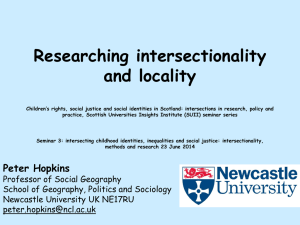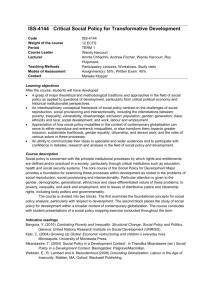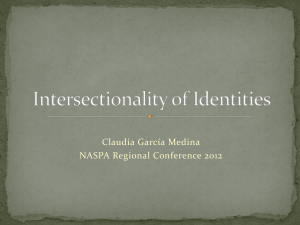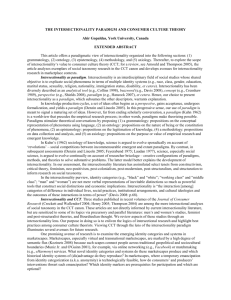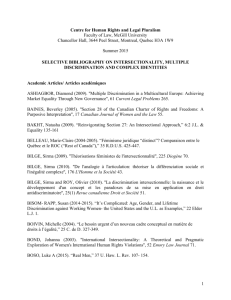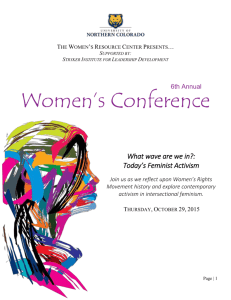Dubrow How Can We Account for Intersectionality in Quantitative
advertisement
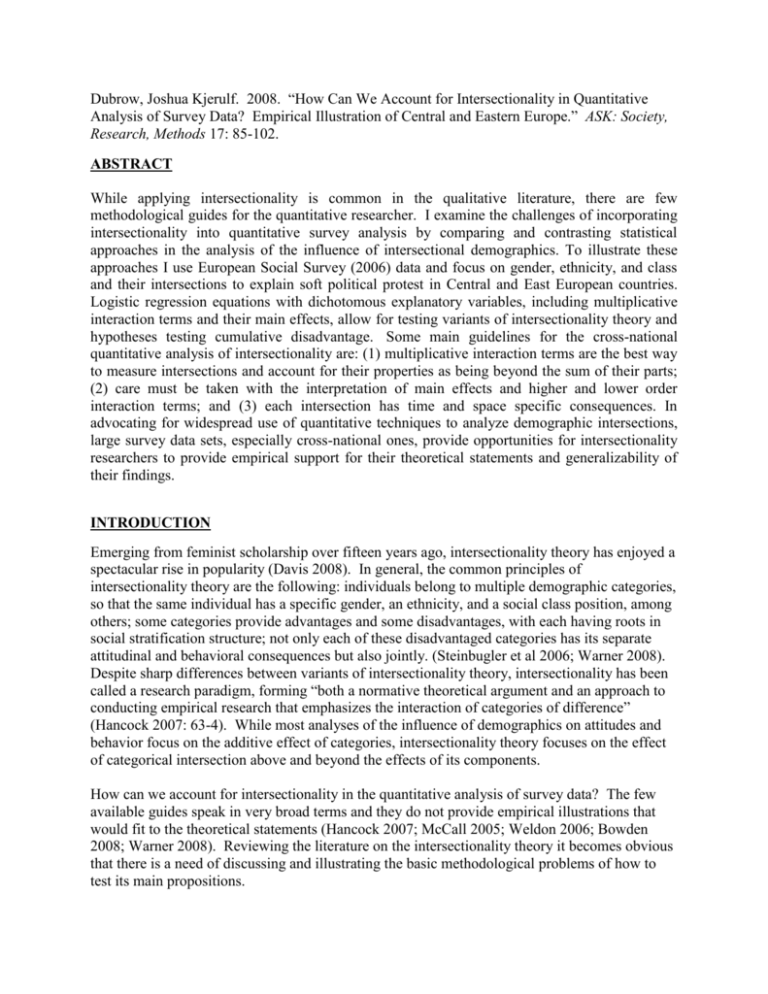
Dubrow, Joshua Kjerulf. 2008. “How Can We Account for Intersectionality in Quantitative Analysis of Survey Data? Empirical Illustration of Central and Eastern Europe.” ASK: Society, Research, Methods 17: 85-102. ABSTRACT While applying intersectionality is common in the qualitative literature, there are few methodological guides for the quantitative researcher. I examine the challenges of incorporating intersectionality into quantitative survey analysis by comparing and contrasting statistical approaches in the analysis of the influence of intersectional demographics. To illustrate these approaches I use European Social Survey (2006) data and focus on gender, ethnicity, and class and their intersections to explain soft political protest in Central and East European countries. Logistic regression equations with dichotomous explanatory variables, including multiplicative interaction terms and their main effects, allow for testing variants of intersectionality theory and hypotheses testing cumulative disadvantage. Some main guidelines for the cross-national quantitative analysis of intersectionality are: (1) multiplicative interaction terms are the best way to measure intersections and account for their properties as being beyond the sum of their parts; (2) care must be taken with the interpretation of main effects and higher and lower order interaction terms; and (3) each intersection has time and space specific consequences. In advocating for widespread use of quantitative techniques to analyze demographic intersections, large survey data sets, especially cross-national ones, provide opportunities for intersectionality researchers to provide empirical support for their theoretical statements and generalizability of their findings. INTRODUCTION Emerging from feminist scholarship over fifteen years ago, intersectionality theory has enjoyed a spectacular rise in popularity (Davis 2008). In general, the common principles of intersectionality theory are the following: individuals belong to multiple demographic categories, so that the same individual has a specific gender, an ethnicity, and a social class position, among others; some categories provide advantages and some disadvantages, with each having roots in social stratification structure; not only each of these disadvantaged categories has its separate attitudinal and behavioral consequences but also jointly. (Steinbugler et al 2006; Warner 2008). Despite sharp differences between variants of intersectionality theory, intersectionality has been called a research paradigm, forming “both a normative theoretical argument and an approach to conducting empirical research that emphasizes the interaction of categories of difference” (Hancock 2007: 63-4). While most analyses of the influence of demographics on attitudes and behavior focus on the additive effect of categories, intersectionality theory focuses on the effect of categorical intersection above and beyond the effects of its components. How can we account for intersectionality in the quantitative analysis of survey data? The few available guides speak in very broad terms and they do not provide empirical illustrations that would fit to the theoretical statements (Hancock 2007; McCall 2005; Weldon 2006; Bowden 2008; Warner 2008). Reviewing the literature on the intersectionality theory it becomes obvious that there is a need of discussing and illustrating the basic methodological problems of how to test its main propositions. NOTE: Accounting for intersectionality is rare in quantitative social science research for a number of reasons (Hancock 2007: 66; Simien 2007: 264). First, it is difficult to capture the complexity intersectionality presents; the most popular places to publish quantitative social science research does not devote space enough for the length such an article would require (McCall 2005: 1787). In addition, research that attempts to account for intersectionality rarely discuss the problems with testing the theoretical assumptions inherent in their models. For example, one cannot assume that intersectionality can always be accounted for with interaction terms, as not all models of intersectionality agree that the constituent elements of the term are meaningful. In building on past research, the aim of this article is to (a) examine the challenges of incorporating intersectionality into quantitative survey analysis; (b) compare and contrast the unitary, or additive approach – the most common way to analyze the influence of demographic variables on attitudes and behavior – with the core of the intersectionality theory, represented by the multiplicative approach; (c) propose the most appropriate statistical means for analyzing each, focusing mainly on multiplicative interaction terms; and (d) illustrate these approaches using the European Social Survey data for Central and East European countries. NOTE: In discussing intersectionality, I do not make reference to the political bases of scientific research, e.g. that categorization leads to oppression. While relevant to understanding intersectionality in its entirety, at this juncture reference to the dialectical relationship of politics and research is beyond the aims of this study. In this paper political protest is the dependent variable. It is well established that the level of political protest in Central and East European countries is much lower than in Western Europe (Dubrow et al. 2008). However, the individual determinants of political protest within Central and East European countries have not been extensively examined. Looking at gender, ethnicity, social class, and their intersection is intended to elucidate the mechanism through which individual attributes influence political behavior. Substantively, I will test the basic propositions of intersectionality theory. Challenges of Incorporating Intersectionality into Quantitative Analysis of Survey Data Applying intersectionality to quantitative analysis of survey data poses several difficult yet surmountable challenges. For example, in the literature it is stressed that variable oriented analyses impose “within-case independence of categories” (Hancock 2007: 66; the history of the argument against variable analysis stretches back many decades: see Blumer 1956). While the original survey data usually have separable demographic categories, combinations of them can be constructed in the form of interaction terms so that categories are not independent of each other. An additional challenge is that surveys are usually not designed with intersectionality in mind and demographic categories are represented in a limited number of cases with which to construct intersections (Hancock 2007: 66; see also Bowleg 2008: 314-317; McCall 2005: 1787). Whether this challenge applies depends on particular surveys. Quantitative researchers interested in the intersectionality paradigm have enough cases for demographic items in the European Social Survey (ESS) to adequately construct and analyze intersections. NOTE: Survey questions such as “are you male or female?” are phrased in such a way as to divorce the categories from their institutional contexts, itself idea that is contrary to the intersectionality paradigm (Hancock 2007: 66). See Bowleg (2008: 314-317) for how to construct survey data with intersectionality in mind. Still another challenge is how to choose among demographic items. A lesson from the democracy and descriptive representation literature is helpful here. When constructing a representative governance body, some choices must be made as to which demographics should be represented. Mansbridge (1999) and Dovi (2004) argued that each body requires a demographic composition appropriate to the task. Thus, social contexts suggest which social cleavages and their intersections are the most salient for intersectional analysis. Cross-national research has demonstrated that gender, ethnicity and class have profound consequences for a wide array of attitudes and behaviors and thus these variables should be tried first. Note, however, that as the intersectionality paradigm progresses, the focus on “master” categories – demographics that are theorized to encompass all aspects of a person’s identity, such as gender — may give way to other, “emergent” – particularized and contextually contingent — categories of heretofore undiscovered but nonetheless salient social cleavages (Warner 2008: 457-9). NOTE: Hancock (2007) advocates Ragin’s fuzzy-set logic approach to guide collection of intersectionality appropriate data. Warner (2008) suggests substituting master categories with constructs: the correlates of the master category can be identified and molded into a construct that has the properties of the master category that are strictly relevant to the attitude or behavior being studied (2008: 461). For example, instead of a dichotomous gender variable, the correlates of being in either one category or another would be identified with existing questionnaire items; the “essential properties of being female” would be the explanatory variable, as opposed to the insensitive “gender” variable. The intersectionality paradigm forces researchers to explore intersectionality in a somewhat inductive way, as existing theories that emerged from the unitary approach are unreliable guides. Weldon (2006) argues that because the intersectionality paradigm does not now provide general principles as to the attitudinal and behavioral consequences of intersecting categories within social systems — other than there are simultaneous advantages and disadvantages — research should be devoted to fleshing out these relationships (245). Both of the intersectionality approaches “changes the relationship between the categories of investigation from one that is determined a priori to one of empirical investigation” (Hancock 2007: 67). Overall, despite concerns regarding the ability of current survey data and quantitative methods to address intersectionality, researchers equipped with these tools are up to the task. Approaches to Understanding Demographics’ Influence In studying the influence of demographic variables on attitudes and behavior, there are two major approaches, with some important internal divisions. The first is unitary, or additive, approach, and the second can be called the multiplicative approach1. I present the essence of these approaches, referring the reader to the literature for the details (Hancock 2007; McCall 2005). NOTE: As researchers use various names for these approaches, I chose names based on what I considered the most intellectually appealing. For unitary, I use Hancock’s 2007 term, and Weldon (2006: 240) suggests the term “monism” for this concept. For variants of intersectionality, I refer to Leslie McCall’s (2005) terms: anticategorical, intracategorical and intercategorical, the last reduced to “categorical approach,” which I refer to as the multiplicative approach, as multiplicative interaction terms are the key element. Anticategorical and intracategorical have nuances that separate them, but the differences are not sufficiently pronounced to suggest fundamentally different statistical approaches. Weldon (2006) refers to McCall’s anticategorical and intracategorical as the Intersectionality-Only model and the categorical approach as the Separable-But-Mutually-Reinforcing model. Unitary, or Additive, Approach Most researchers employ the unitary approach. Its main theoretical assumptions are that (a) demographic categories have social properties that are distinct from the other characteristics of individuals, and (b) a separate category could be a the best predictor of the dependent variable (Hancock 2007; Weldon 2006). In the unitary approach, it is assumed that demographic variables have additive effects. For example, the joint effect of being a woman, belonging to an ethnic minority, and representing disadvantaged social class is seen as a sum of the effects of these three demographic variables. Multiplicative Approach Multiplicative approach is also called categorical (McCall 2005). In intersectionality theory, the influence of demographics on a social outcome is conditional on the intersections of the demographic categories. Thus, interaction terms of categories identifying respondents are advocated for in this approach. In this more relaxed version of intersectionality theory, it is assumed that the constituent elements of intersections have valid social meaning. Moreover, this approach “begins with an analysis of the elements [of the intersections] first because each of these is a sizable project in its own right” [emphasis mine] (McCall 2005: 1787). The constituent elements of intersections are there to provide context for the intersections themselves (Weldon 2006). Versions of intersectionality theory range from more relaxed to more strict. In the strictest version, it is assumed that “social life is considered too irreducibly complex… to make fixed categories anything but simplifying social fictions…” (McCall 2005: 1773). Gender, ethnicity, and class are inseparable as each has no valid social meaning on their own. This “anticategorical” approach assumes that each constituent category of the intersection has no autonomous effects (McCall 2005; Weldon 2006: 240). While I focus on the multiplicative approach, I briefly discuss methodological implications of the anticategorical approach. Research Question: Intersectionality and Political Participation Dubrow, Joshua Kjerulf. 2008. “How Can We Account for Intersectionality in Quantitative Analysis of Survey Data? Empirical Illustration of Central and Eastern Europe.” ASK: Society, Research, Methods 17: 85-102. Socially stratified political participation is an ideal subject to explore intersectionality. Research in political participation consistently show that disadvantaged groups – measured in terms of their gender, ethnicity, and class — participate less, and thus have lesser influence in government policy and legislation (APSA Task Force 2004, Gallego 2008). The main question is, to what extent do intersections of disadvantage within gender, ethnicity and class groups influence participation? The main hypothesis is that intersectional identities influence political participation, so that it is lower for those with cumulative disadvantage. Cumulative disadvantage implies that the more disadvantaged categories represented by individuals, the lower the probability of political protest. Cumulative disadvantage is what some intersectionality scholars call the additive approach, where “each dimension of disadvantage creates some distinct advantages and disadvantages that combine by adding onto one another” (Weldon 2006: 242). Other scholars argue for considering explicitly the combination of categories, though this, too, can incorporate the concept of cumulative disadvantage by comparing levels of disadvantage among types of intersections. I examine data according to these two approaches. DATA AND MEASUREMENT Data come from European Social Survey, ESS, Round Three (2006). ESS is a cross-sectional, cross-national dataset with individuals as the units of analysis. I focus on disadvantaged groups of new democracies in Central and Eastern Europe: Bulgaria, Estonia, Hungary, Poland, Slovakia, Slovenia and Ukraine3. Dubrow et al (2008) explored soft political protest among the democracies of Europe and found that disadvantaged groups in new democracies engage less in soft political protest than those in old democracies. The effect of disadvantaged intersection is most likely to be found and have the greatest magnitude in the new democracies of Europe. The dependent variable is engagement in soft political protest. Soft political protest is similar to “conventional” protest, which includes legal demonstration and signing petitions (Jenkins and Form 2005). Added here is contacting a politician, government or local government official because soft political protest may be exercised in alternative forms in various countries. In particular, in one country signing a petition can be treated as the functional equivalent of contacting a politician or official in another country. This seems to be especially relevant in countries with weak petition-signing culture, as is the case in new democracies (see Inglehart and Catterberg 2002). I classify a case as representing soft political protest if the respondent pro¬vided a positive answer to at least one of the items: contact official, sign petition, and attend lawful public demonstration. Idiosyncratic national patterns suggest that the three indicators should be treated as alternative expressions of soft political protest rather than cumulative ones—that is, those measuring the intensity of the underlying common phenomenon. Thus, for each country included in the ESS wave I created a dichotomy, dividing all respondents into those who engaged in any of three forms (denoted 1) and the rest (denoted 0). As independent variables, I use dichotomous variables with disadvantaged groups as the focal category, and non-disadvantaged groups as the reference category. Specifically: Gender is coded with woman = 1, man = 0. Ethnicity is constructed from the combination of (a) respondents answering “yes” to the question, Do you belong to a minority ethnic group in [respondent’s country]? and (b) positive answers to the question, On what grounds is your group discriminated against? in terms of at least one of the following: the color or race, nationality, language and ethnic group. Thus, ethnicity is coded with self-report of minority status and/or discrimination based on ethnicity = 1, otherwise = 0. I constructed disadvantaged class by dividing the lower end of the EGP class schema (Erikson and Goldthorpe 1992) from the rest, where unskilled workers, agricultural laborers, and selfemployed farmers = 1, otherwise = 0 (including those without an occupational code). In new democracies of Central and Eastern Europe, as elsewhere, members of these class categories are marked as disadvantaged as they typically have the least access to and amount of valued resources, such as income, education and status (Heyns 2005). These class members tend not to do participate in political actions (Gallego 2008). Empirical Illustrations Dubrow, Joshua Kjerulf. 2008. “How Can We Account for Intersectionality in Quantitative Analysis of Survey Data? Empirical Illustration of Central and Eastern Europe.” ASK: Society, Research, Methods 17: 85-102. NOTE: The Russian Federation– available in ESS Round Three – is a clear outlier in terms of social heterogeneity. To simplify the empirical illustrations, I omit Russia from analyses that are unnecessarily complicated by such outliers. As the purpose of these illustrations is to propose analytical strategies with major demographic variables, I include only gender, ethnicity, and class, and their intersections, and do not include standard control variables (such as age, income, and education; see Dubrow et al 2008 and Gallego 2008). For the additive approach, the logistic regression equation can be expressed as: log(p/1-p) = a + β1gij + β2eij + β3c3ij + rij where (p/1-p) is the probability the respondent engaged in soft political protest, i refers to individual, j refers to the country, g refers to gender, e refers to ethnicity, and c refers to class; r is the error term. The model assumes that none of the explanatory variables — gender, ethnicity, and class — has a positive effect on soft political protest. This model accounts for cumulative disadvantage in a sense that β 1 + β 2 + β 3 < 0. Thus, the best way to use this equation is to (a) show that master categories have statistically significant negative effects on soft political protest and (b) determine the presence of cumulative disadvantage separable identities by adding up the coefficients. Table 1 presents the effects of gender, ethnicity, and class on soft political protest for all and each of the Central and Eastern European countries of this study. For all countries combined, gender, ethnicity and class are statistically significant and in a direction consistent with that of previous studies. Any one of these identities decreases the probability of soft political protest. CLICK ON THE TABLE FOR THE FULL VIEW With one exception the hypothesis that none of the explanatory variables — gender, ethnicity, and class — has a positive effect on soft political protest is supported: when coefficients are significantly different from 0, the signs are negative. The exception is ethnicity in Hungary: ethnic minority is more involved in soft protest that the rest of the population. Note that in Poland the size of ethnic minority is very small (1,05 percent), and the equation is estimated without that demographic variable. The main result of this analysis is that the research hypothesis stating that β 1 + β 2 + β 3 < 0 has empirical support for all countries (-1,275), and individually for Bulgaria (-3,114), Estonia (1,262), Hungary (-0,111), Poland (-1,117), Slovenia (-0,845), Slovakia (-0,531) and Ukraine (1,889). The effect of particular categories depends on their distribution. To standardize their impact, I multiplied each coefficient by standard deviation of their respective variable (Kaufman 1996). Table 2 provides semi-standardized coefficients and sum of them. For all countries combined, semi-standardized coefficients reveal that if gender would be distributed in the same way as ethnicity, then gender would have a greater effect than ethnicity. In ranking countries by the sum of their coefficients, there is no difference between Table 1 and Table 2. There are differences in the relative impacts of some of the categories within countries. Comparing standardized and unstandardized coefficients, in Ukraine class changes from having the second-most to the greatest level of disadvantage, and gender from last to second. Table 2 Semi-Standardized Effects of Gender, Ethnicity, and Class on Soft Political Protest for Central and Eastern European Countries and Their Sums Country All Bulgaria Estonia Hungary Poland Slovenia Slovakia Ukraine Gender -0,153 -0,139 0,085 -0,119 -0,238 -0,148 -0,156 -0,269 Ethnic -0,105 -0,494 -0,264 0,130 –a 0,044 0,002 -0,159 Class -0,275 -0,656 -0,364 -0,197 -0,304 -0,300 -0,097 -0,288 Sum -0,533 -1,289 -0,543 -0,186 -0,542 -0,404 -0,252 -0,716 Note: Significant coefficients of at least p<0,10 in bold. a Not calculated due to insufficient number of cases. To compare the relative probabilities of soft political protest, Table 3 presents odds ratios of soft political protest for gender, ethnicity and class for Central and East Central Europe for both unstandardized (U) and semi-standardized (S) coefficients. Substantively, the results are similar to that of Table 2, but the odds ratios provide a clear picture of relative probabilities among demographic categories. For all countries combined, membership in disadvantaged class decreases probability the most (46 percent), followed by ethnicity (30 percent) and gender (26 percent). Across countries, disadvantaged class membership leads to the largest decrease in protest probability — 48 percent, on average, which is twice that of the mean gender effect. Some probabilities are particularly striking: In Bulgaria, disadvantaged class membership decreases probability by 78 percent, while in Hungary, ethnic minorities, even if they are women of a disadvantaged class, increases probability of protest by 17 percent. Table 3 Odds Ratios of Soft Political Protest for Gender, Ethnicity and Class for Unstandardized (U) and Semi-Standardized (S) Coefficients Gender Ethnic Class Country U S U S U All 0,735 0,704 0,540 0,858 0,900 Bulgaria 0,753 0,870 0,274 0,215 0,610 Estonia 1,186 1,089 0,561 0,425 0,768 Hungary 0,786 1,730 0,658 0,888 1,139 Poland 0,621 –a –a 0,527 0,788 Slovenia 0,742 1,261 1,045 0,459 0,862 Slovakia 0,731 1,005 1,002 0,800 0,855 Ukraine 0,580 0,486 0,536 0,764 0,853 Note: Significant coefficients of at least p<0,10 in bold. a Not calculated due to insufficient number of cases S 0,760 0,519 0,695 0,821 0,738 0,741 0,908 0,750 In the multiplicative approach, intersectionality implies that the relationship between the person and the attitude or behavior is conditional upon intersecting identities. In interaction effects the relationship between the constituent elements of the explanatory variables is changed with the introduction of a third variable: “the association appears under certain conditions, and it disappears or changes in intensity or direction when other conditions happen” (Agresti and Finlay 1999: 369). In this version, to test for intersectionality, interaction terms are required (Brambor et al 2006; Weldon 2006: 242-244; McCall 2005: 1787-1788; Bowleg 2008). Using interaction terms for testing intersectionality theory involves a couple of complications. First, significance of interaction terms depends on the size of the main effects. Since main effects, more often than not, should be included in the model along with the interaction terms (Brambor et al 2006), the chance of finding empirical support for intersectionality theory is reduced. However, a sufficiently large sample size can improve chances of discovering significance of interaction terms. Another complication is that intersectionality frequently calls for more than two variables. Interactions of higher order, i.e. more than two variables, must be considered. Interpretations of a single equation with higher order and lower order interactions can be tricky and great care must be taken in interpreting them (Braumoeller 2004: 810). Interaction effects are expressed through cross-product terms created by multiplying two or more of the explanatory variables together. In this case we have the following interactions: genderethnicity, gender-class, ethnicity-class, and gender-ethnicity-class. First three interactions are of the second order, and the second is of the third order. Accordingly the logistic regression equation can be expressed as, log(p/1-p) = a + β1gij + β2eij + β3c3ij + β4(ge)ij + β5(gc)i j + β6(ec)i i + β7(gec)ij + rij As omitting lower order interactions can produce biased results, all possible interactions from this combination of demographics are included in the model (Βraumoeller 2006: 811). Thus we can formulate the following research hypotheses: β1+ β2 + β4 < 0 β1 + β3 + β5 < 0 β2 + β3 + β6 < 0 and β1 + β2 + β3 + β4 + β5 + β6(ec)i i+ β7 < 0 Table 4 shows all these hypotheses are supported by the data. Table 4. Logistic Regression of Soft Political Protest on Gender, Ethnicity and Class, Including Interactions, for Central and Eastern European Countries Gender Ethnic Class Interactions Gender – Ethnic Gender – Class Ethnic – Class Gender – Ethnic – Class Constant B -0,298** -0,643** -0,567** SE 0,059 0,168 0,088 EXP(B) 0,742 0,526 0,567 0,453* -0,165 0,566* -0,764† -1,260** 0,222 0,136 0,284 0,439 0,043 1,573 0,848 1,761 0,466 0,284 Log Likelihood 10141,570 Chi2 156,924** N 11371 ** p<0,01 *p<0,05 †p<0,10 Total effect of all variables is statistically significant. Interpreting the total effect of particular intersections with unstandardized coefficients, all intersections, including ethnic – class (β2 + β3 + β6 = -0,556), decreases probability of protest. Cumulative disadvantage is evident, as the higher order interaction decreases probability of protest more (72 percent) than any of the lower order terms (e.g. gender-class reduces probability by 62 percent). Gender-ethnic-class variable is remarkable as coefficients for three-way interactions are rarely as robust. As this is a cross-national study, controlling for country effects is important. Table 5 presents results from a logistic regression of the response variable on gender, ethnicity and class, including interactions and country effects, with the Russian Federation in the reference category. Substantive changes are for particular countries. In comparison with Russia, the country effect of some increase probability of protest (Estonia, Hungary, Slovenia, Slovakia and Ukraine) and for others it decreases (Bulgaria and Poland). The gender-ethnic intersection actually increases probability in Slovenia (0,081) and Slovakia (0,056). In Bulgaria, the gender-ethnic-class intersection decreases probability by 75 percent. A graph clearly displays cumulative disadvantage and relative impact of intersections. I constructed a variable that measures how many disadvantaged categories a respondent has that ranges from zero (no disadvantage identity) to three (having all three disadvantaged identities). Figure 1 presents the predicted probabilities of soft political protest for each category of the variable. Distance between demographics within each category corresponds to the coefficients in Table 4. This graph clearly illustrates (a) the huge gap in protest probability between those with no disadvantaged identities and those with all three, (b) the cumulative effects of disadvantage on protest probability, and (c) relative disadvantage between types of intersections. Figure 1. Predicted Probability of Soft Political Protest by Respondent’s Number of Disadvantaged Identities Legend: g = gender, e = ethnicity, c = class While the strictest version of intersectionality theory — the anticategorical approach — suggests different statistical methods, the procedures that created Figure 1 can be fruitfully applied to it. A common way to address the anticategorical approach is by analysis of subsamples, i.e. creating separate datasets for each intersection and performing statistical analyses on them. In this empirical illustration, this means conducting z-tests on the percentage of each intersection that engages in protest. The results from this analysis are not substantially different from that presented in Figure 1, and as such I advocate conducting the multiplicative model as outlined above instead of analysis of subsamples. Note, however, that there are several problems with applying the anticategorical approach to multivariate regression. Theoretically, according to the anticategorical approach, main effects are fictional demographic categories that obscure the influence each full-bodied intersection has on the response variable. Thus, the constituent elements of the interaction terms do not have meaning in and of themselves, and this approach would exclude them from the equation. Applying this may have severe consequences for multivariate regression models. When main effects are not included along with interaction terms the model may have misspecification error. Strong statistical or theoretical conditions for not including main effects must be present, and these conditions are rarely met (Brambor et al 2006: 66 – 71). Since anticategorical approaches advocate inductive methods, i.e. theory obscures discovery (Hancock 2007: 67), there are no strong theoretical grounds. There may be statistical grounds, and this requires a careful checking of multicollinearity diagnostics. In general, such a model is too risky, and therefore should be a rarity. CONCLUSION AN DISCUSSION To account for intersectionality in quantitative analysis of survey data, I compared and contrasted two approaches. The unitary approach is a useful starting point to understanding the influence of master demographic categories, but can never lead to discovery of emergent categories. Of the multiplicative variants of intersectionality theory, the categorical approach is the most user-friendly, as it allows for the greatest array of statistical procedures. This more relaxed version of intersectionality theory calls for analyzing mainly interaction terms. To avoid misspecification of the model, the constituent elements of the terms must be included into analysis. For quantitative analysts wanting to account for intersectionality theory with existing survey data, interaction terms are the best way to measure intersections. Dichotomous variables are the most straightforward. Because intersections can be quite complex, great care must be taken with the interpretation of main effects and higher and lower order interaction terms (Baumoeller 2004). Doing intersectionality research with cross-national survey data raises a difficult question: In intersectionality’s search for the effects of “categories of difference” (Hancock 2007: 63-4), what role does cross-national comparison play? As intersections are inseparable from their societal contexts, country level effects should be considered. I addressed this issue by considering country level processes that generate disadvantaged categories within social groups. In practical terms, I selected countries based on common political, economic and social characteristics, such as level of democracy, economic development, and historical and cultural heritage. I also analyzed separate effects for each country on the response variable, with surprising results. This cross-national study reminds that each intersection has time and space specific consequences. Criticisms of the additive approach fail to give proper credit to quantitative analysis as a practical way to address the impact of disadvantaged identities. Intersectionality theory rightly advocates the complexity of individuals. But to understand this complexity, there must be ways to determine which identities are advantaged and which are disadvantaged, in what contexts and to what extent. As illustrated here, quantitative techniques make possible such accounting that not only allows for valid comparisons across countries, but also among types of very complex intersections. Thus, although the majority of intersectionality research is done using qualitative methods, intersectionality theorists should embrace quantitative techniques to develop the intersectionality paradigm. Large survey data sets, especially cross-national ones, provide opportunities for intersectionality researchers to provide empirical support for their theoretical statements and generalizability of their findings. We need to stop wondering whether quantitative analysis of survey data is appropriate for accounting for intersectionality. The challenge now is to strengthen the bond between intersectionality theory and quantitative techniques. References APSA Task Force on Inequality and American Democracy. 2004. American Democracy in an Age of Rising Inequality. www.apsanet.org/imgtest/taskforcereport.pdf. (accessed July 4, 2007) Blumer, Herbert. 1956. “Sociological Analysis and the ‘Variable.’” American Sociological Review 21(6): 683-690. Bowleg, Lisa. 2008. “When Black + Lesbian + Woman ≠ Black Lesbian Woman: The Methodological Challenges of Qualitative and Quantitative Intersectionality Research.” Sex Roles 59: 312- 325. Brambor, Thomas, William Roberts Clark and Matt Golder. 2006. “Understanding Interaction Models: Improving Empirical Analyses.” Political Analysis 14:63-82. Braumoeller, Bear F. 2004. “Hypothesis Testing and Multiplicative Interaction Terms.” International Organization 58: 807-820. Davis, Kathy. 2008. “Intersectionality as Buzzword: A Sociology of Science Perspective on What Makes a Feminist Theory Successful.” Feminist Theory 9(1): 67-85. Dubrow, Joshua Kjerulf, Kazimierz M. Slomczynski and Irina Tomescu-Dubrow. 2008. “Effects of Democracy and Inequality on Soft Political-Protest in Europe: Exploring the European Social Survey Data.” International Journal of Sociology 38(3): 36 – 51. Erikson, Robert, and John H. Goldthorpe. 1992. The Constant Flux: A Study of Class Mobility in Industrial Societies. Oxford: Clarendon Gallego, Aina. 2008. “Unequal Political Participation in Europe.” International Journal of Sociology 37 (4): 10 – 26. Hancock, Ange-Marie. 2007. “When Multiplication Doesn’t Equal Quick Addition: Examining Intersectionality as a Research Paradigm.” Perspectives on Politics 5(1): 63-79. Heyns, Barbara. 2005. “Emerging Inequalities in Central and Eastern Europe.” Annual Review of Sociology 31:163-197. Inglehart, Ronald, and Gabriela Catterberg. 2002. “Trends in Political Action: The Developmental Trend and the Post-Honeymoon Decline.” International Journal of Comparative Research 43, nos. 3–5: 300–316. Jenkins, J. Craig, and William H. Form. 2005. “Social Movements and Social Change.” In Handbook of Political Sociology: States, Civil Society and Globalization, ed. Thomas Janoski, Robert R. Alford, Alexander M. Hicks and Mildred A. Schwartz, 331–49. Cambridge: Cambridge University Press. Kaufman, Robert L. 1996. “Comparing Effects of Dichotomous Logistic Regression: A Variety of Standardized Coefficients.” Social Science Quarterly 77(1): 90 – 109. McCall, Leslie. 2005. “The Complexity of Intersectionality.” Signs: Journal of Women in Culture and Society 30(3): 1771 – 1800. Steinbugler, Amy C. and Julie E. Press, Janice Johnson Dias. 2006. “Gender, Race and Affirmative Action: Operationalizing Intersectionality in Survey Research.” Gender & Society 20(6): 805-825. Weldon, S. Laurel. 2006. “The Structure of Intersectionality: A Comparative Politics of Gender.” Politics & Gender 2(2): 235-248. see also “Rethinking Intersectionality” by this author. Warner, Leah R. 2008. “A Best Practices Guide to Intersectional Approaches in Psychological Research.” Sex Roles 59: 454-463. SEE ALSO: An annotated bibliography of many current intersectionality articles and unpublished research. Hughes, Melanie. 2008. Politics at the Intersection: A Cross-National Analysis of Minority Women’s Legislative Representation. PhD. Dissertation. The Ohio State University.


